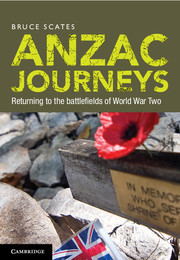Book contents
- Frontmatter
- Contents
- Maps
- Illustrations
- Acknowledgements
- Money, measurement and terminology
- Introduction
- PART 1 CAPTIVITY NARRATIVES
- 1 ‘If only I knew what has become of him’: The loss of Australia's prisoners of war
- 2 Witness to war: The first journeys
- 3 Bring up the bodies: Commemorating our war dead
- 4 Unspeakable histories: From Singapore to Hellfire Pass
- 5 The Death March: Journeys back to Sandakan
- PART 2 DESERT AND ISLAND
- PART 3 AIR AND SEA
- PART 4 AUSTRALIA'S FRONT LINE
- Conclusion
- Notes
- Index
2 - Witness to war: The first journeys
from PART 1 - CAPTIVITY NARRATIVES
Published online by Cambridge University Press: 05 June 2013
- Frontmatter
- Contents
- Maps
- Illustrations
- Acknowledgements
- Money, measurement and terminology
- Introduction
- PART 1 CAPTIVITY NARRATIVES
- 1 ‘If only I knew what has become of him’: The loss of Australia's prisoners of war
- 2 Witness to war: The first journeys
- 3 Bring up the bodies: Commemorating our war dead
- 4 Unspeakable histories: From Singapore to Hellfire Pass
- 5 The Death March: Journeys back to Sandakan
- PART 2 DESERT AND ISLAND
- PART 3 AIR AND SEA
- PART 4 AUSTRALIA'S FRONT LINE
- Conclusion
- Notes
- Index
Summary
Following the attacks on Pearl Harbor in December 1941, Japanese forces moved swiftly through South-East Asia. The speed of the Japanese advance saw many thousands of Australian, British, Dutch and Allied servicemen and women taken prisoner. They would soon become part of a vast slave-labour force, along with many more local and indigenous people. Men of the AIF, RAN and RAAF and the women of the Australian Army Nursing Service were captured in Malaya, Singapore, Java, Timor, Ambon and Rabaul in early 1942. Even so, the POW story still centres on Singapore (where the greatest number of prisoners was taken), Thailand and Borneo, where thousands laboured and many died.
In the wake of any war comes the witness. Witnesses are men and women who testify with the authority of direct experience. They are the survivors of battles and atrocities, whose lives were swept up in tragedy or trauma, who resolve to speak out against the most unspeakable of crimes. Historians have labelled them ‘moral witnesses’. Burdened with ‘a terrible tale to tell’, their whole sense of self is often defined by their stories.
This chapter looks at three different kinds of witness testimony about the prisoner-of-war experience under the Japanese. The first two concern survivors who returned to the sites of imprisonment soon after the end of the war. The third is a documentary made by an Australian journalist who journeyed through Borneo gathering material.
- Type
- Chapter
- Information
- Anzac JourneysReturning to the Battlefields of World War Two, pp. 28 - 51Publisher: Cambridge University PressPrint publication year: 2013



